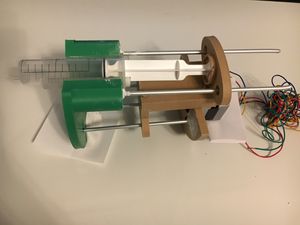
Design concept for syringe pump; non-functional
Project
For a functional and tested design see Open-source syringe pump.
Motorized syringe pumps are commercially available for eg. laboratory work but they are often expensive. Thus, an open-source version has been developed (see link above).
This project aimed at inproving the OS syringe pump design. While conceptual idea was sound, the mechanical functionality fell short. With the more detailed knowledge of the materials needed the concept can be improved. One needed addition would be the stepper side being higher, or an outer hull structure keeping it all together.
Concept
The idea of a syringe pump is to convert the stepper motor's rotation to linear movement. The threaded rod, when rotating, moves the screw or a similar part alongside it's axis. The concept in this is to move the end of the syringe plunger above the stepper motor so that the lenght of the product is shortened to a lenght little more than the lenght of the sum of the syringe cylinder and plunger. This is achieved by moving the plunger head above the stepper motor.
Design
Bill of Materials
- 1x NEMA 17 stepper motor
- 1x 5 mm - 5 mm shaft coupling (threader rod diameter - stepper shaft diameter. Both can change, but small steppers have 5 mm shaft)
- 1x M5 threaded rod, 10 cm
- 1x ball bearing for the above
- 1x lead screw or bolt
- 2x M5 threaded rod, 15 cm
- 8x M5 bolts
- 2x 5mm metal rods, lenght 20 cm
- 4x linear bearings for the rods
- 1x 6 cm of thin metal wire or 2x sowing pins
- Stepper driver chip, Arduino or similar, etc.
3D printed parts:
- Syringe holder
- Syringe side wall
- middle part 1
- middle part 2
- stepper wall
Estimated Cost
Estimated cost for the project in this state exceeds the previous superior design with 3d printed parts being rather big; the design needs work. The lowest cost is 10–20 € if parts can be ordered with longer shipping time.
Conclusions and improvement ideas
The project did not yield a finished product, it gave a great number of improvement ideas and tips:
Cons:
- The upper part rods cannot, even with structure extending, be without connections at the other end
- The rod lengths vary and may not be standard lenghts
- The middle part (slider) may need rods through it, stabilizing the whole thing considerably
- The structural (outer) rods must have exceedingly sturdy connections to the parts, or a hull structure must be printed
Pros:
- Middle part is actually very sturdy and works
- Plunger attachment with (copper) wires/needles/pins through small holes seem to be holding the plunger tight
- The concept for a separate plunger holder that attaches to the whole structure may be good for slightly differing pump sizes
Files
stl and freely modifiable openscad source file can be found at concept design: parallel-axis syringe pump
Designer Tuomas T. Hämäläinen, student at Aalto University, as part of the course 3D Printing of Open Source Hardware for Science












